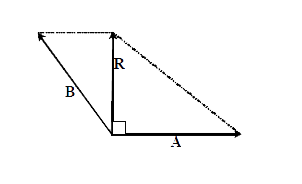If the resultant of two forces is equal in magnitude to one of the components and perpendicular to it direction, find the other components using the vector method.
Video Solution
Text Solution
Let P be horizontal in the direction of unit vector ˆi. The resultant is also P but perpendicular to it in the direction of unit vector ˆj. If Q is the other force making an angle θ(obtuse) as the resultant is perpendicular to P, then the two forces are PˆiandQcosθˆi+Qsinθˆj. Their resultant is Pˆj. Therefore,
Pˆj=Pˆi+(Qcosθˆi+Qsinθˆj)
Comparing the coefficients of ˆiandˆj, we get
P+Qcosθ=0andQsinθ=P
or Qcosθ=−PandQsinθ=P
Squaring and adding Q=P√2 and dividing give
tanθ=−1
θ=135∘

|
Updated on:21/07/2023
Topper's Solved these Questions
- BOOK - CENGAGECHAPTER - INTRODUCTION TO VECTORS EXERCISE - Exercise 1.120videos
INTRODUCTION TO VECTORS
- BOOK - CENGAGECHAPTER - INTRODUCTION TO VECTORS EXERCISE - Exercise 1.27videos
INTRODUCTION TO VECTORS
- BOOK - CENGAGECHAPTER - INTEGRALSEXERCISE - Solved Examples And Exercises324videos
INTEGRALS
- BOOK - CENGAGECHAPTER - INVERSE TRIGONOMETRIC FUNCTIONSEXERCISE - Question Bank24videos
INVERSE TRIGONOMETRIC FUNCTIONS
Similar Questions
Knowledge Check
- Question 1 - Select One
If the resultant of two forces is of magnitude P and equal to one of them and perpendicular to it, then the other force is
APBP√3CP√2D2P√3 - Question 2 - Select One
Resultant of two vector of equal magnitude A is
A√3Aat60∘B√2Aat90∘C2Aat120∘DAat180∘ - Question 3 - Select One
The resultant of two vectors of same magnitude is equal to the magnitude of one of the vectors, then the angle between them is
A30∘B60∘C90∘D120∘
Vector component of vector →b perpendicular to →a is
View SolutionEquality of vectors in terms of components
View SolutionAddition of vectors using components
View SolutionTwo vector →A and →B have equal magnitudes. Then the vector →A+→B is perpendicular :
View SolutionIf component of one vector in the direction of another vector is zero, then those two vectors
View Solution

